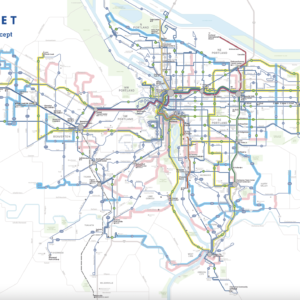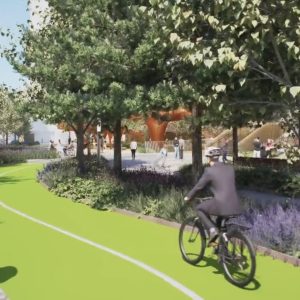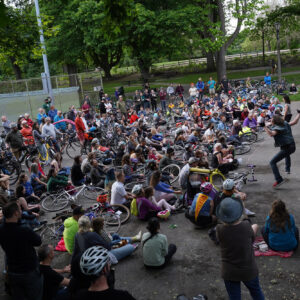The existing LOS standards and measures, which focus only on motor vehicle levels of service, do not reflect the City of Portland’s current practice which emphasizes and promotes a multimodal approach to transportation planning and providing transportation services.
— From the City of Portland RFP
If you or any of your friends are transportation wonks, then you already know how powerful “level of service” (LOS) standards are. For the uninitiated, LOS is a measurement tool used by traffic engineers and planners to grade how a road or intersection “performs” in terms of traffic flow. If vehicles roll through without delay, the road performs well and gets an “A” LOS grade, if vehicles screech to a standstill and traffic backs up, the section of roadway gets an “F”. (I’m sure someone in the comments can give a more accurate/nuanced definition.)
The issue comes up in nearly every transportation project that includes bicycle access — because as cities make room for better bicycling, they are bound by these LOS standards to make sure a new design doesn’t lower the LOS of a particular street. Recall the considerable heartburn PBOT engineers faced on the N Williams Avenue project as they pondered whether or not they would endorse a one standard lane cross-section for the entire project. PBOT traffic engineer Rob Burchfield wanted to honor the communities desires for a cross-section that would tame auto traffic; but he said the City had to “make sure we have adequate capacity for the volume of traffic we expect,” and that, “there are some pass/fail criteria,” — LOS standards — they had to work with. That’s just one example.
The big problem with LOS is that it only takes automobile and truck trips into account. There is no official “bicycle level of service” nor do existing LOS standards include any consideration of bicycle traffic. For cities like Portland that want to design a transportation system that doesn’t put cars up on a pedestal, this gap in LOS policy is a significant barrier. It’s preventing us from making decisions today that will allow us to reach our goals tomorrow.
I’ve heard grumblings from insiders for years now that Metro was working on a new system, but I’ve yet to see official details. Now it appears that the City of Portland has taken a big step forward. According to a request for proposals (RFP) I came across today, the Bureau of Planning & Sustainability is looking for consultants to help them “implement a performance measures policy to replace the existing motor vehicle level of service policy in Portland’s Transportation System Plan.”
Here’s more from the RFP (emphasis mine):
…The City of Portland has existing performance standards in its Transportation System Plan (TSP) that are based on level of service (LOS) measures for motor vehicles. These include intersection based LOS measures that are used as a basis for determining the adequacy of transportation services in development review applications and volume-to- capacity (v/c) measures that are used in project and system planning. The existing LOS standards and measures, which focus only on motor vehicle levels of service, do not reflect the City of Portland’s current practice which emphasizes and promotes a multimodal approach to transportation planning and providing transportation services.
Portland’s current policy uses motor vehicle performance measures to determine the adequacy of transportation services. At the same time, the City has goals to increase the proportion of total trips using modes that are alternatives to the automobile, including pedestrian, bicycle, and transit (bus, streetcar, light rail), and has made a significant investment in facilities benefitting these other modes. The performance standards are used by the City to determine the impacts different land uses will have on the transportation system. The performance standards only measure vehicle performance and there is a concern that they do not give credit to the benefits of facilities and land use patterns that encourage the use of other modes.
The City of Portland has been wanting to do away with the old-school LOS guidelines for many years. The RFP mentions a 2005 effort that resulted in a draft memo a few years later they say should be the “stepping off point for this project.”
The reason this is coming now is because the City is beginning the process of updating the Comprehensive Plan and the Transportation System Plan (TSP) which lives within it.
You can read the RFP and the 2007 draft memo of the City’s “level of service policy prototype” via this PDF. The RFP deadline is August 17th and work on the $100,000 project is expected to proceed by mid-September.
— For more on level of service, read this excellent series from Streetsblog SF.






Thanks for reading.
BikePortland has served this community with independent community journalism since 2005. We rely on subscriptions from readers like you to survive. Your financial support is vital in keeping this valuable resource alive and well.
Please subscribe today to strengthen and expand our work.
I’m all for getting rid of crazy, car-centric LOS requirements, but please be aware that the 2010 edition of the Highway Capacity Manual *does* include a bicycle level of service calculation, and its criteria are are at least somewhat reasonable. I think the standard should probably be that any project that has to take car LOS into account also has to take bicycle, pedestrian, and transit LOS into account.
If this is done right, it could mean huge things for alternative transportation in Portland.
Exciting!
And always interesting to see a bureaucratic machine catch up with facts on the ground….
Bravo, City of Portland. Let’s lead by example again and hope ODOT doesn’t attempt to put a kibosh on this.
LOS guidelines should be defined by the community needs, not just those of automobile drivers. Multimodal should mean a balance of the needs of private autos, public buses and rail, bicycles, and pedestrians and measured per the needs of a particular community.
Great story. Looking forward to updates.
Woohoo! This is amazing news! Good on you, City of Portland
Besides from a transport perspective, this could be big for livable cities. Many of our most beloved sidewalk cafe and strolling retail main streets are LOS F (NW 23rd is a great example) and yet these outdated standards prevent the creation of new pedestrian oriented main streets.
This is great, but it will also take cooperation from the state bodies that review/approve plans (LCDC, etc.) — there are a lot of strong, statewide land-use planning laws that hinge on current LOS standards
This is the first in a long series of steps that will enable us to do things like removing the east bank freeway some day. This is a huge step in the right direction.
Nice — this has been a huge hole in bicycle network evaluation for decades. Without an evaluation metric, they can’t set policy. Without policy, we’re stuck with poorly performing facilitie (relative to other modes, like cars, trucks, buses, etc) that have them.
Ted Buehler
I think they should scrap the whole concept of LOS and use a livability index instead. Noise and pollution should be minimized and safety maximized while maintaining a minimum level of people moving (regardless of mode).
Alta Planning and Design, go get ’em!
By the way, Chris, we (at Alta) have decided not to pursue this project. We’re very invested in the outcome, and we can’t wait to see what happens, but the right firm for the job will have to know more about vehicle modeling and performance metrics than we do. Thanks for your attaboy, though.
This is great news…but wait … If we break the auto LOS standards that generate concurrency requirements for Oregon suburban road widening then how will I get my suburban bike lanes to nowhere? 🙂
When you get bike lanes in the ‘burbs they won’t be to “Nowhere” but part of an interconnected network exactly like the current street network, but separated from it, and cars will have to go the long way around. http://www.aviewfromthecyclepath.com/
This is good news. I will be interested in the outcome. Changing State of Oregon and City of Portland policies regarding how LOS is used might be a start. I think that intersection LOS could be argued is an appropriate tool for roadways that function only as ‘mobility corridors’ (i.e. Marine Drive). However, streets within ‘destinations’ (neighborhood centers, main streets and downtowns) should have strong bias toward pedestrians and bicyclists, especially at intersection points of conflict. To achieve this pedestrian and bike prioritization, motor vehicle congestion should be tolerated or even encouraged at intersections. LOS should be ignored or at the very most a minor consideration. Applying this ‘destination’ policy, Williams would have had a different outcome.
Yeah but Marine Drives doesnt even work as a mobility corridor withthr LOS system…how many crashes have occurred on it this week? This is the most dangerous road in the region.
should have been done 20 years ago
Level of service is based on “control delay.” It’s basically the amount of time associated with slowing, waiting for a light or appropriate gap, and getting back up to speed. There are differnt values for traffic signals and for stop or yield control at intersections. Agencies already have standards that differentiate the amount of delay that is acceptable by location (eg more delay is acceptable downtown) and, sometimes, by type of street (eg arterials).
I’d be reluctant to scrap LOS as suggested by some. Too much delay on the arterial streets definitely causes increases in cut-through traffic. That has plenty of impact on my neighborhood liviability.
You should also be aware that ODOT does not use level of service, they use the volume-to-capacity ratio.
Talk about Level of Service – I was one of at least 20 bikes lined up at SE Grand & Madison this morning, next to two empty car lanes with exactly FOUR cars waiting. It’s not just cars that make up “traffic” in this city!
So any updates on the alternative LOS?
Has there been any movement on this yet? I’d love to point to Portland and try for something similar in Gainesville, FL…